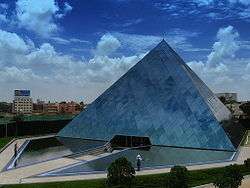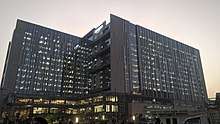Information technology in India
Information Technology in India is an industry consisting of two major components: IT services and business process outsourcing (BPO).[1] The sector has increased its contribution to India's GDP from 1.2% in 1998 to 7.7% in 2017.[2] According to NASSCOM, the sector aggregated revenues of US$180 billion in 2019,[3][4] with export revenue standing at US$99 billion and domestic revenue at US$48 billion, growing by over 13%. As of 2020, India's IT workforce accounts for 4.36 million employees.[5][6] The United States accounts for two-thirds of India's IT services exports.[7]


History
India's IT Services industry was born in Mumbai in 1967 with the creation of Tata Consultancy Services[8] who in 1977 partnered with Burroughs which began India's export of IT services.[9] The first software export zone, SEEPZ – the precursor to the modern-day IT park – was established in Mumbai in 1973. More than 80 percent of the country's software exports were from SEEPZ in the 1980s.[10]
Within 90 days of its establishment, the Task Force produced an extensive background report on the state of technology in India and an IT Action Plan with 108 recommendations. The Task Force could act quickly because it built upon the experience and frustrations of state governments, central government agencies, universities, and the software industry. Much of what it proposed was also consistent with the thinking and recommendations of international bodies like the World Trade Organization (WTO), International Telecommunications Union (ITU), and World Bank. In addition, the Task Force incorporated the experiences of Singapore and other nations, which implemented similar programs. It was less a task of invention than of sparking action on a consensus that had already evolved within the networking community and government.
Regulated VSAT links became visible in 1994.[11] Desai (2006) describes the steps taken to relax regulations on linking in 1991:
In 1991 the Department of Electronics broke this impasse, creating a corporation called Software Technology Parks of India (STPI) that, being owned by the government, could provide VSAT communications without breaching its monopoly. STPI set up software technology parks in different cities, each of which provided satellite links to be used by firms; the local link was a wireless radio link. In 1993 the government began to allow individual companies their own dedicated links, which allowed work done in India to be transmitted abroad directly. Indian firms soon convinced their American customers that a satellite link was as reliable as a team of programmers working in the clients’ office.
A joint EU-India group of scholars was formed on 23 November 2001 to further promote joint research and development. On 25 June 2002, India and the European Union agreed to bilateral cooperation in the field of science and technology. India holds observer status at CERN, while a joint India-EU Software Education and Development Center will be located in Bangalore.[12]
Contemporary situation
In the contemporary world economy, India is the largest exporter of IT. Exports dominate the Indian IT industry and constitute about 79% of the industry's total revenue. However, the domestic market is also significant, with robust revenue growth.[2] The industry's share of total Indian exports (merchandise plus services) increased from less than 4% in FY1998 to about 25% in FY2012. The technologically-inclined services sector in India accounts for 40% of the country's GDP and 30% of export earnings as of 2006, while employing only 25% of its workforce, according to Sharma (2006). According to Gartner, the "Top Five Indian IT Services Providers" are Tata Consultancy Services, Infosys, Wipro, and HCL Technologies.[13]
Major information technology hubs
Bangalore
Bengaluru is known as the Silicon Valley. [14][15] Notable tech park are Electronics City Phase I & II, ITPL, Bagmane Tech Park, Embassy Golf Links, Manyata Tech Park, Global Village Tech Park, Embassy TechVillage.
Hyderabad

Hyderabad – known for the HITEC City or Cyberabad – is a major global information technology hub, and the largest bioinformatics hub in India.[16][17] Hyderabad has emerged as the second largest city in the country for software exports pipping competitors Chennai and Pune.[18][19][20] As of 2020, the IT exports from Hyderabad was ₹128,807 crore (US$ 15 billion), the city houses 1500 IT and ITES companies that provide 582,126 employment.[21][22][23][24] Notable tech and pharma parks are HITEC City, Genome Valley, and Hyderabad Pharma City
Chandigarh
Chandigarh is also one of the growing international IT services and outsourcing exporters. The next upcoming tech park will be world trade center.[25]
Kolkata

Kolkata is the financial and business hub of Eastern India. The metro city has seen a significant rise in IT services. In August 2018, the West Bengal Government has announced that 200 acres of land in Rajarhat Newtown will be used for the development of Bengal Silicon Valley, similar to the California Silicon Valley in San Francisco, USA.[26] The main intention of this project is to create a business-friendly environment for IT companies to set up their business in the city.
Chennai
As of 2012, Chennai is India's Largest exporter of information technology (IT) and business process outsourcing (BPO) services.[27][28] Tidel Park in Chennai was billed as Asia's largest IT park when it was built.[29][30] Notable tech parks are International Tech Park, DLF SEZ, Mahindra World City, SIPCOT IT Park, Olympia Tech Park and Ramanujan IT City. City has a expressway called as IT expressways and a preferred location for IT industries. Major software companies have their offices set up here, with some of them making Chennai their largest base.[28]
Pune
The Rajiv Gandhi Infotech Park in Hinjawadi is a ₹600-billion (US$8.9 billion) project by the Maharashtra Industrial Development Corporation (MIDC).[31][32] The IT Park encompasses an area of about 2,800 acres (11 km2) and is home to over 800 IT companies of all sizes.[33] Besides Hinjawadi, IT companies are also located at Magarpatta, Kharadi and several other parts of the city. As of 2017, the IT sector employs more than 300,000 people.[33][34]
See also
References
- Nirmal, Rajalakshmi. "IT's time for ctrl+alt+delete". The Hindu. Retrieved 26 February 2017.
- "nformation technology/business process management (IT-BPM) sector in India as a share of India's gross domestic product (GDP) from 2009 to 2017". NASSCOM. Archived from the original on 20 December 2012. Retrieved 15 December 2012.
- Singh, Shelley (14 September 2017). "Home market gets attractive for India's IT giants". Retrieved 3 August 2019 – via The Economic Times.
- "IT industry may become lighthouse for India's growth; here's how many IT firms operate in India". financialexpress.com. Retrieved 3 February 2020.
- "From TCS and Infosys to Microsoft and Kissflow — this is how productivity increases".
- "IT companies power critical services, can't let all work from home".
- "Amid IT layoffs, this could be a reason to cheer - Times of India". The Times of India.
- "Top 50 Emerging Global Outsourcing Cities" (PDF). www.itida.gov.eg. Archived from the original (PDF) on 21 September 2018. Retrieved 22 July 2010.
- "Special Economic Zones: Profits At Any Cost". Doccentre.net. Archived from the original on 7 September 2010. Retrieved 22 July 2010.
- "Top 50 Emerging Global Outsourcing Cities" (PDF). www.itida.gov.eg. Archived from the original (PDF) on 21 September 2018. Retrieved 22 July 2010.
- "Online Journal of Space Communication". Spacejournal.ohio.edu. Retrieved 28 September 2013.
- Inc, lbp (2013). India Telecom Laws and Regulations Handbook. Int'l Business Publication. p. 300. ISBN 1433081903.
- "Gartner Says Top six Indian IT Services Providers Grew 23.8 Percent In 2011". Gartner.com. 7 May 2012. Retrieved 28 September 2013.
- Canton, Naomi. "How the 'Silicon' is bridging the digital divide". CNN. Retrieved 6 December 2012.
- RAI, SARITHA. "Is the Next Silicon Valley Taking Root in Bangalore?". New York Times. Retrieved 20 March 2006.
- Udgirkar, Trushna. "New innovation support centre to open in Hyderabad this month".
- "Hyderabad to emerge as new biotechnology capital of India: Experts". www.PharmaBiz.com. Retrieved 3 November 2017.
- "Hyderabad Pips Chennai, Pune in Software Exports". The New Indian Express.
- "CDFD to be Sun's first CoE in medical informatics". timesofindia-economictimes.
- "Hyderabad Pips Chennai, Pune in Software Exports". newindianexpress.com. Retrieved 1 April 2018.
- "Telangana records 17.93 % growth in IT sector". The Times of India. 21 May 2020. Retrieved 21 May 2020.
- "Telangana IT exports grows 18% at ₹1.28 lakh crore in FY20".
- "Hyderabad overtakes Bengaluru in IT office space occupation".
- "Hyderabad IT companies told to gradually ramp up operations".
- "World Trade Center launched in Chandigarh Vikash". The Economic Times. 7 December 2015. Retrieved 28 February 2019.
- https://www.thestatesman.com/cities/mamata-launches-bengal-silicon-valley-hub-1502673008.html
- "Chennai activities". NASSCOM. Archived from the original on 16 November 2012. Retrieved 28 December 2012.
- Chandramouli, Rajesh (1 May 2008). "Chennai emerging as India's Silicon Valley?". The Economic Times. Retrieved 28 December 2012.
- "Ford's Rs. 200-cr. IT hub in Chennai". The Hindu. Chennai. 2 November 2000. Retrieved 28 December 2012.
- "Work ethics: How Indian cities fare". Rediff. Retrieved 28 December 2012.
- Bari, Prachi (7 December 2007). "Hinjawadi, the land of opportunity". The Economic times. India. Archived from the original on 9 May 2009. Retrieved 13 November 2009.
- "Hinjawadi IT park". The MegaPolis. Archived from the original on 18 March 2009. Retrieved 13 November 2009.
- Banerjee, Shoumojit (27 May 2017). "Pune, where panic reigns an IT campus". The Hindu. ISSN 0971-751X. Archived from the original on 27 May 2017. Retrieved 13 June 2018.
- "Economic Times (2010), Are IT jobs losing sparkle?". Economictimes.indiatimes.com. 27 August 2010. Retrieved 30 August 2010.
Sources
- Sharma, Dinesh C. (2015). The Outsourcer: The Story of India's IT Revolution. MIT Press. ISBN 9780262028752.
- Parayil, G. (2016). Political Economy and Information Capitalism in India: Digital Divide, Development Divide and Equity Technology, Globalization and Development. Springer. ISBN 9780230595613.
- Vittal, N.; Mahalingam, S. (2001). Information Technology: India's Tomorrow. Manas Publications. ISBN 9788170491194.
- Franda, Marcus F. (2002). China and India Online: Information Technology Politics and Diplomacy in the World's Two Largest Nations. Rowman & Littlefield. ISBN 9780742519466.
- Ezer, Jonathan (2010). Perceptions of Information Technology in India: A study of the institutional forces that impact how technology is taught, and learned, at Indian Universities. LAP Lambert Academic Publishing. ISBN 9783838372792.